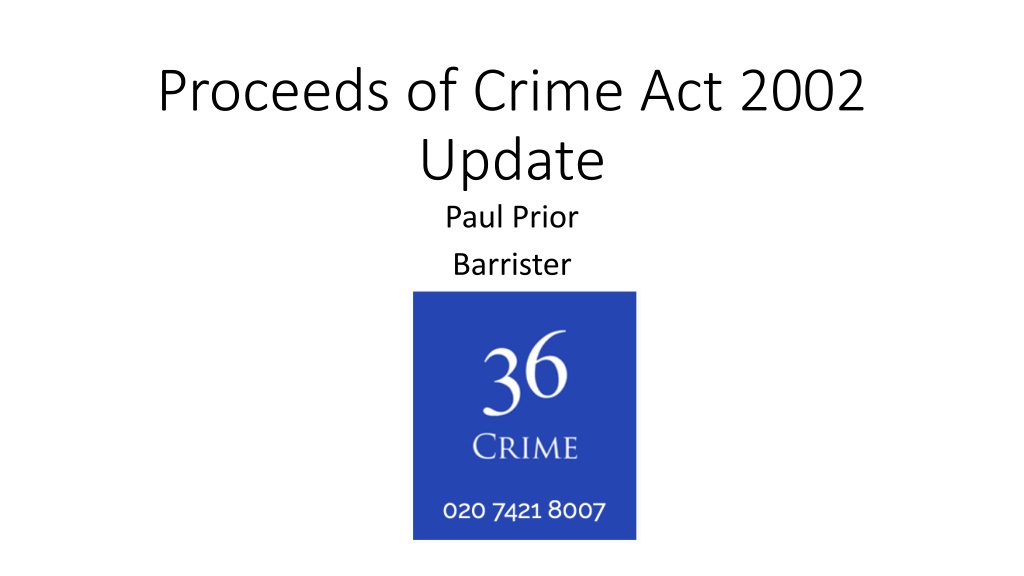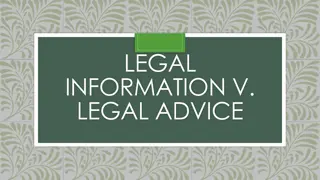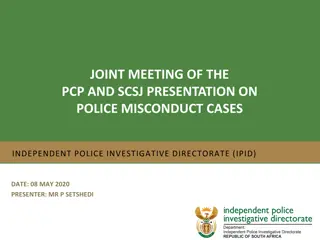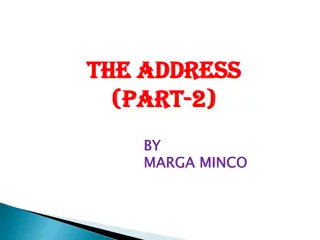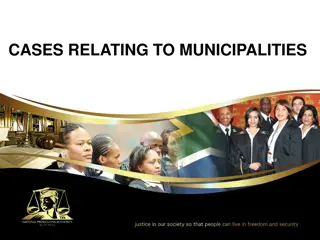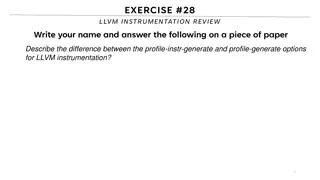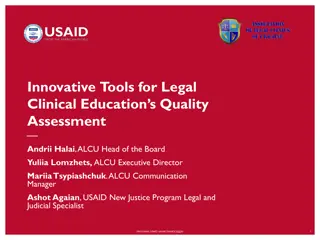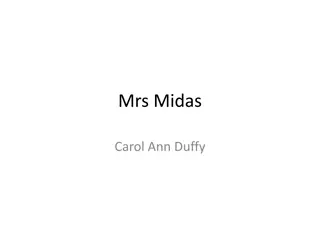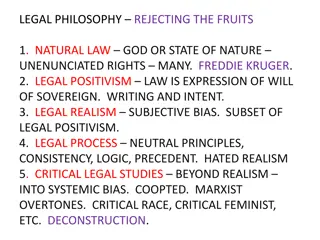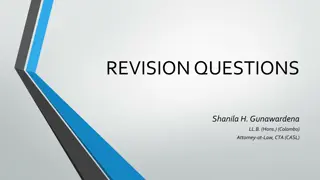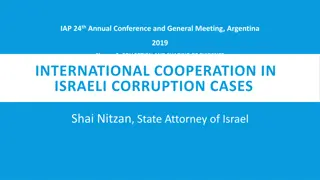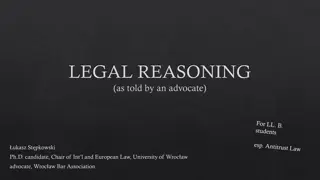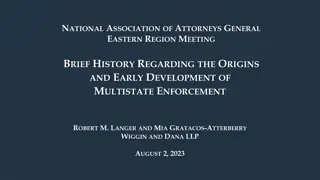High-profile Legal Cases Involving Mr. and Mrs. Lam
Legal cases involving Mr. and Mrs. Lam include charges of fraudulent evasion of VAT, laundering proceeds, criminal lifestyle assessment, and disputes over property ownership. Mrs. Lam's involvement, the marital home's value, and the establishment of a constructive trust are central issues in these complex proceedings.
Download Presentation

Please find below an Image/Link to download the presentation.
The content on the website is provided AS IS for your information and personal use only. It may not be sold, licensed, or shared on other websites without obtaining consent from the author. Download presentation by click this link. If you encounter any issues during the download, it is possible that the publisher has removed the file from their server.
E N D
Presentation Transcript
Proceeds of Crime Act 2002 Update Paul Prior Barrister
Beneficial Ownership of Spouse Chin Lam v Crown [2022] EWCA Crim 448 Mr. Lam pleaded guilty to three counts on an indictment which alleged that he was knowingly concerned in the fraudulent evasion of VAT. He had operated two restaurants, each through a different company at the O2 Limited. They both charged VAT to their customers but did not submit VAT returns and kept the money. This began in 2012 and ended at different dates, the most recent date being April 2017. He was sent to prison for three years. Mrs. Lam was charged along with Mr. Lam on a count of laundering the proceeds, but when he pleaded guilty the case against her was dropped and a not guilty verdict entered.
R v Lam This was a criminal lifestyle case Mr. Lam was charged on 16 April 2018 which means that the relevant period for the assessment of his benefit extended back as far as 16 April 2012. Coincidentally this happens to be about the time when the offending began. The benefit was agreed as 1,018,508 plus an increase for inflation. The only asset available to meet a confiscation order was 11 Cavendish Road. This was the matrimonial home where the appellants, who are married, lived since 2010. The available amount was the value of his beneficial interest in it.
R v Lam First, Mr. Lam contended that the value of 11 Cavendish Road was 650,000- 750,000 and that the equity after payment of the first mortgage of 603,135.88 was therefore limited. Secondly, he contended that that equity was entirely extinguished as a result of a second legal charge which he had granted to his sister s husband on 18 February 2018. The judge rejected both of these arguments. She found that the value of 11 Cavendish Road was 1,000,000. She found that the legal charge given to Mr. Lam s brother in law was a tainted gift and that it did not operate to reduce the available amount. There is no appeal against the above determination. 11 Cavendish Road was sold not very long after the decision for 1,050,000.
R v Lam Mr. and Mrs. Lam contended that the legal interest in this property was held by Mr. Lam subject to a constructive trust for them both in equal shares. The legal title is vested in him alone. They say that this trust was founded on their common intention that they would jointly own their home in which they intended to live together for the rest of their lives. The judge considered documentary evidence, and heard oral evidence principally from Mrs. Lam on this issue. Mr. Lam provided some written evidence. Mrs. Lam was unable to explain many of the transactions about which she was asked.
R v Lam Mrs Lam came to the UK from Malaysia in 1973 and trained as a nurse, qualifying in 1976. Mr and Mrs Lam married in 1985. Their elder son, Jonathan, was born later that same year. They purchased their first property, a flat at 54 Kings Court, in 1987. That property was held in joint names, subject to a joint mortgage. Mrs Lam's recollection in oral evidence was that she had contributed 8000 towards the deposit, raised from her savings in Malaysia. She could not remember whether Mr Lam had contributed to the deposit or not. Mr and Mrs Lam's daughter, Joanne, was born in 1991. The family moved in 1997 to 31 Kernerne Drive, Barnet. That property was bought for 148,000 and registered in their joint names, subject to a joint mortgage in favour of Abbey National PLC. Mrs Lam continued to work full-time as a nurse between 1976 and 1997, including the periods when her two elder children were born. She gave up work and taken on the role of full-time mother and housekeeper towards the end of 1997, after the house move. In her affidavit, Mrs Lam stated that, prior to giving up work in 1997, she had contributed from her salary to the joint mortgage and household outgoings. In 2005, an 8-bedroom property at 57 Victoria Road North, Portsmouth was purchased for the sum of 320,000, in their joint names, subject to mortgage. Mr Lam provided no evidence as to how the purchase of this property had been financed. In her police interview on 20 July 2017, Mrs Lam said that 57 Victoria Road was purchased by Mr Lam from the sale of a previous business. She understood that the business was a success and that Mr Lam was bought out by associates. The property was put in her name because Mr Lam already had a mortgage in his name, and so she thought they might get a better rate on the mortgage. This was not her idea, but it sounded sensible and lawful, so she agreed. She said "we own 50% and another of my husband's associates own the other 50%".
R v Lam Both Mr and Mrs Lam provided various documents relating to their wills. On 14 September 2005 they both executed wills. In summary, each left everything to the other. 11 Cavendish Road The Official Copy in respect of 11 Cavendish Road shows that Mr Lam was registered as sole proprietor with title absolute to the property on 15th January 2007. The price stated to have been paid on 21 December 2006 is recorded as 395,000. Mr Andrews, the financial investigator, confirmed in cross-examination that the mortgage payments and bills for 11 Cavendish Road were paid from the joint account. Mrs Lam stated that the reason that the payments were set up in that way was because they intended to share the financial responsibilities for the house together. In oral evidence Mrs Lam said that she and Mr Lam shared all the money.
R v Lam Mr Lam gave no evidence as to his intention at the time of the purchase of 11 Cavendish Road, or subsequently, as to whether Mrs Lam would have a share in the beneficial interest, and no evidence of any discussions between them as to whether she would have a share. In his section 18 response he asserted that although the property was in his sole name, Mrs Lam had an equitable interest of 50% in the property, as the property was their family home, and referred to her affidavit. In her affidavit Mrs Lam said that the property was purchased in 2006 and put in the sole name of Mr Lam, subject to a mortgage in his sole name. At the time of the purchase she and Mr Lam jointly owned 31 Kenerne Drive, and they intended to sell that property once 11 Cavendish Road was ready to live in. As the couple's only source of income was from Mr Lam, the mortgage was based on his salary alone, and it therefore made sense to put the mortgage and the property in his sole name. She stated that it was their intention as a married couple that the property would be shared equally between them as their new family home. She said that this intention was reflected in their wills, which she described as being made "just before this property was purchased".
R v Lam In oral evidence Mrs Lam said that 11 Cavendish Road was intended by her and Mrs Lam to be their retirement home. Mrs Lam said that Mr Lam dealt with all the administration in connection with the purchase of 11 Cavendish Drive. In cross- examination she agreed that Mr Lam dealt with most of the financial dealings during the marriage. Asked about matters such as deposit, mortgage, mortgage rates, she said any big things that she didn't understand, he dealt with. She dealt with the day-to- day household bills, groceries and so on. She said she was not concerned about the property being in Mr Lam's sole name. Everything they had was for each other and for the family. Whether the property was in his name or hers didn't matter: it was theirs, their home. Mrs. Lam rejected the suggestion that the reason 11 Cavendish Road was in Mr. Lam s sole name was because the Portsmouth property in hers was treated as being in lieu of her interest in 11 Cavendish Road. She did not suggest, however, that this was a discussed and agreed position between her and Mr. Lam.
R v Lam There was very limited evidence as to the history of payments made under the mortgage. In 2011, 31 Kenerne Drive was sold for 350,000. The net proceeds of sale of that property were 201,218.29. Mrs Lam provided a copy of a statement dated 1 September 2011 from Mr and Mrs Lam's joint Halifax account showing that those monies were credited to that account on 31 August 2011. The statement shows that the opening balance on the account on 30 August 2011 was - 8,794.42. On 1 September 2011 a number of substantial withdrawals were made from the account by cheque. No explanation was advanced for those payments. A payment described as "DD -The Mortgage Bus" in the sum of 840.46 appeared to be a payment towards the mortgage. The closing balance on September was 131,942.54. In oral evidence Mrs Lam said that the proceeds of sale of 31 Kenerne Drive were used to pay the mortgage and household bills and to fund household spending. In reply to questions in cross-examination she said that Mr Lam had used some of the monies for the business, and the rest was left in the joint account for their own use.
R v Lam The Crown Court Judge then summarised the evidence from Mr. Lam about his own income during the period after the purchase and development of 11 Cavendish Road. The evidence left many questions unanswered but showed that after 1997 Mrs. Lam produced very little income and had very little capital. Her income tax returns showed an income from one or more of Mr. Lam s companies, but it appeared that he had created these documents and she knew nothing about them. It had come as a surprise to her that she was stated to be an employee of the various companies. She knew that money was coming into the joint account, but she had thought it was Mr Lam's salary. She now appreciated that declarations had been made in her name to HMRC in respect of earnings from the company in her name.
R v Lam The Prosecutions document By Schedule 1 to the Legal Mortgage dated 18th February 2018 and made between (1) Boon Chen Loy (Lender) and (2) Chin Seong Lam (Borrower), Mr Lam represented and warranted as follows: 1. That he was the legal and beneficial owner of the property and had good and marketable title to the property 2. That the property was free from any encumbrances other than (a) a charge dated 29 June 2007 in favour of the Mortgage Business; and (2) the legal charge created by this legal mortgage 3. That apart from the encumbrances referred to in paragraph 2, the Borrower had not received or acknowledge notice of any adverse claim by any person in respect of the Property or any interest in it. It appears from this document, and absent any other explanation, that Mr Lam's instructions to the solicitor who drew it up must have been that he was the sole legal and beneficial owner of the property. Mrs Lam's evidence was that she had not known about the charge, and Mr Lam had not discussed it with her.
R v Lam the Law [Page 11, Para. 12 of Judgment] The leading authorities in relation to the approach to be taken by the courts in assessing the beneficial interest held by parties in matrimonial homes are the decisions of the House of Lords in Stack v Dowden [2007] 2 AC 432 and of the Supreme Court in Jones v Kernott [2007] 2 AC 432. Both of those cases involve a situation, unlike the present situation, where the property was registered in joint names, and one party sought to assert a beneficial interest of more than 50%.
R v Lam the Law In Jones v Kernott the Court set out the principles applicable in a case where a family home is purchased in the joint names of a cohabiting couple, both of whom are responsible for any mortgage, but without any express declaration of their beneficial interests at paragraph 51: (1) The starting point is that equity follows the law and they are joint tenants both in law and in equity. (2) That presumption can be displaced by showing (a) that the parties had a different common intention at the time when they acquired the home, or (b) that they later formed the common intention that their respective shares would change. (3) Their common intention is to be deduced objectively from their conduct: "the relevant intention of each party is the intention which was reasonably understood by the other party to be manifested by that party's words and conduct notwithstanding that he did not consciously formulate that intention in his own mind or even acted with some different intention which he did not communicate to the other party
R v Lam the Law (4) In those cases where it is clear either (a) that the parties did not intend joint tenancy at the outset, or (b) had changed their original intention, but it is not possible to ascertain by direct evidence or by inference what their actual intention was as to the shares in which they would own the property, "the answer is that each is entitled to that share which the court considers fair having regard to the whole course of dealing between them in relation to the property": Chadwick LJ in Oxley v Hiscock [2005]Fam 211, para 69. In our judgment, "the whole course of dealing ... in relation to the property" should be given a broad meaning, enabling a similar range of factors to be taken into account as may be relevant to ascertaining the parties' actual intentions. (5) Each case will turn on its own facts. Financial contributions are relevant but there are many other factors which may enable the court to decide what shares were either intended (as in case (3)) or fair (as in case (4)).
R v Lam the Law They set out their view (in obiter remarks) as to the approach to be adopted by the courts where the legal title was registered is one party's name only. The starting point is different. The first issue is whether it was intended that the other party have any beneficial interest in the property at all. If he does, the second issue is what that interest is. There is no presumption of joint beneficial ownership. But their common intention has once again to be deduced objectively from their conduct. If the evidence shows a common intention to share beneficial ownership but does not show what shares were intended, the court will have to proceed as at para 51 (4) and (5) above.
R v Lam the Law In Stack v Dowden at paragraphs 69 and 70, Baroness Hale set out the following non-exhaustive list of factors which may be relevant to divining the parties' true intentions: In law, 'context is everything' and the domestic context is very different from the commercial world. Each case will turn on its own facts. Many more factors than financial contributions may be relevant to divining the parties' true intentions. These include: any advice or discussions at the time of the transfer which cast light upon their intentions then; the reasons why the home was acquired in their joint names; the reasons why (if it be the case) the survivor was authorised to give a receipt for the capital moneys; the purpose for which the home was acquired; the nature of the parties' relationship; whether they had children for whom they both had
R v Lam the Law responsibility to provide a home; how the purchase was financed, both initially and subsequently; how the parties arranged their finances, whether separately or together or a bit of both; how they discharged the outgoings on the property and their other household expenses. When a couple are joint owners of the home and jointly liable for the mortgage, the inferences to be drawn from who pays for what may be very different from the inferences to be drawn when only one is owner of the home. The arithmetical calculation of how much was paid by each is also likely to be less important. It will be easier to draw the inference that they intended that each should contribute as much to the household as they reasonably could and that they would share the eventual benefit or burden equally. The parties' individual characters and personalities may also be a factor in deciding where their true intentions lay. In the cohabitation context, mercenary considerations may be more to the fore than they would be in marriage, but it should not be assumed that they always take pride of place over natural love and affection.
R v Lam the Law The following principles emerge. The starting point is that equity follows the law: where the legal title is vested in the name of one party alone, the evidential burden is on the person who seeks to establish that she has a share in the beneficial interest to show a common intention to share beneficial ownership. The court's task is to determine the common intention of the parties objectively from their conduct, taking into account factors such as those mentioned by Baroness Hale in Stack. If the person asserting that they have a share satisfies that burden, the second issue is what that interest is. There is no presumption that the sharing is equal.
Lam Crown Court Judgment [Pg 14 para 13] This is a case where Mr and Mrs Lam, who remain a couple, are seeking together to assert that Mrs Lam has a share in the beneficial interest in their home. Mrs Lam has not previously asserted any such claim. Mr Lam has denied any such claim on the part of Mrs Lam until the commencement of these proceedings. There is an obvious motivation to make and concede such a claim now, to seek to preserve part of the value of the house, for their joint future benefit. In my judgment I am entitled to draw the inference that further evidence, which could have been provided and which has not been provided, has not been provided because it would not support Mrs Lam's claim to a 50% share in the beneficial interest, but might tend to undermine it
R v Lam Mr Lam, in executing the 18th February 2018 Legal Charge in favour of Mr Loy, warranted that he was the sole legal and beneficial owner of the property. According to Mrs Lam's evidence, he did not discuss his intention to execute the charge with her at all. In my judgment, absent any explanation, this warranty is telling evidence of his intention as to the beneficial interests at the time the charge was executed.
R v Lam I do not accept the submission made on behalf of both Mr and Mrs Lam that somehow Mrs Lam's contribution to the family falls to be taken into account. That contribution would be relevant in a matrimonial case, and might be relevant in a joint names case, but the property interests in this sole name case fall to be determined according to property law. The relationship provides the context, but is not to be counted as if it were a monetary contribution. I do not accept the submission that the 2005 wills cast any substantial light on Mr and Mrs Lam's intended joint beneficial ownership of a property purchased in December 2006.
R v Lam As to Mrs Lam's contribution of the 50,000 paid towards the cost of building works, I do not accept that the fact that those monies were asked for by Mrs Lam, and paid by Mr Loy on behalf of his wife into Mrs Lam's sole NatWest account, necessarily means that they were provided beneficially by Mrs Lam, or that the use of those monies to pay bills outstanding in respect of the construction project necessarily supports an inference that Mrs Lam was intended to have a beneficial interest in the house.
Court of Appeal [Page 23, para 18] We have come to the conclusion that the judge s determination of Mr. Lam s beneficial interest in 11 Cavendish Road at 100% cannot be sustained. This is because an examination of her paragraph 148 of the judgment holds by implication that Mrs. Lam s contribution to the family is irrelevant as a matter of law. The judge said that it might be relevant in a matrimonial case or a joint names case, but that the case before her had to be decided according to property law . The judge s subsequent reasoning is then entirely concerned with whether and to what extent Mrs. Lam made a financial contribution to the purchase price of 11 Cavendish Road, or paid any of the mortgage payments. This is an error of law, as her summary of the law at paragraphs 81 and 82 of her judgment, quoted in full at our paragraph 12 above, makes clear. In our judgment it is not right to say that evidence going to these issues which might be relevant in a joint names case is not relevant as a matter of law in a single name case. The exercise is the same in both types of case: to ascertain whether the common intention of the parties was that the legal ownership of an asset should he held on trust, and if so what the terms of that trust were.
Court of Appeal The judge was right to evaluate the evidence she had heard in detail and to address the many problems in it. However, it might also have helped to stand back and look at the overall picture. A working wife had contributed to the family finances by contributing her income and some savings. She had also looked after the children and homes while the husband attended to his business. There was no reason to reject any of this evidence. When they bought their first two matrimonial homes the properties were in joint names and there would be no reason why equity would not follow the law in that instance. The last matrimonial home was acquired in a complex way, because it was purchased as a bungalow and then re-developed. During the long period when that was happening and while it was being funded in various ways which never became entirely clear, the family lived in the previous, jointly owned, matrimonial home.
Court of Appeal [Page 24, para 21-22] The Court repeated the Judge s words: There is an obvious motivation to make and concede such a claim now, to seek to preserve part of the value of the house, for their joint future benefit. This, in our judgment, acknowledges the reality of the position. However opaque and devious Mr. Lam s dealings have been over the years, there is really no reason to doubt Mrs. Lam s evidence that as far as they were both concerned their family wealth, including in particular their home, was jointly owned for their joint benefit There are certainly many missing documents and much missing information. If the central plank of their case, joint beneficial ownership of the family home, were implausible these things would be fatal to it; but actually it is not implausible at all. There is really only one piece of evidence which militates against it, which is Mr. Lam s arrangement of the transfer of the legal title of the home into his sole name. This is unexplained.
R v Lam First, we find that her approach to the Legal Mortgage dated 18 February 2018 and made between (1) Boon Chen Loy (Lender) and (2) Chin Seong Lam (Borrower) was unjustified. She found elsewhere in her judgment that this was a genuine legal charge created by Mr. Lam in favour of Mr. Loy but was a tainted gift actually designed by Mr. Lam to defeat the confiscation proceedings. The prosecution case was that it was a sham and thus conferred no beneficial interest in 11 Cavendish Road on Mr. Loy. The judge did not make that finding but held that it was effective to create a charge in favour of Mr. Loy to secure repayment of the loans made nine years earlier. It was carefully structured so that Mr. Loy could not force the sale of the property.
R v Lam The significance of this question to the present appeals is that the judge decided that the fact that Mr. Lam had declared that he was the sole legal and beneficial owner of the property in this (from his point of view) dishonest document was telling evidence that this was true. Since she rejected almost everything else which Mr. Lam had ever said, and since she gave a detailed and convincing explanation of his life of deceit and fraud, this is rather puzzling. It would seem that the reason why the charge was not a sham was that it was accepted in good faith by Mr. Loy, and that it reflected the agreement he thought he was entering into. From Mr. Lam s point of view the charge was simply to preserve his home from the reach of the then anticipated confiscation proceedings, so that he and his wife could live in it. Although it did not, on its face, look like a gift by him that is what the judge held that it was.
R v Lam It follows from this finding that the available amount is 50% of the proceeds of sale of 11 Cavendish Road after payment of the mortgage granted in 2007 in favour of the Mortgage Business. The available amount is not reduced to any extent by the charge in favour of Mr. Loy, by reason of the findings made by the judge. We say nothing further about the status of the charge in favour of Mr. Loy. There was no appeal in relation to that and the issue is not before us. It has been determined under s10A (Mr. Loy being present and represented as a person who held or may have held an interest in the property) that the charge was created by Mr. Lam alone and that Mrs. Lam did not know about it. It contained a false declaration by him that he was the sole legal and beneficial owner of the property and had good and marketable title to the property.
Shetaya AMR SHETAYA v METROPOLITAN POLICE SERVICE [2022] EWHC 1426 (Admin) Highbury Corner Magistrates Court made an order under s.295(2) of the Proceeds of Crime Act 2002 extending by a further six months the period for which an estimated 65,000 of cash seized by the police from the Appellant, Mr. Amr Shetaya, could be detained by them. On 15 March 2021 the Appellant was intending to fly to Egypt from London Heathrow Airport, but the airline s staff sought to verify his Covid test certificate. The police contacted the pharmacy which, according to the appellant, had carried out the test. The pharmacy said that they had not done so and that they had been told of other fake Covid certificates.
Shetaya The appellant was arrested. The police searched his luggage. In each of two large suitcases they found three brown envelopes, each marked with the figure 10,000. These envelopes had been placed inside soft laptop bags lined with kitchen foil. The police described this as a technique used to avoid the identification of a bag s contents by x-ray. The police also found an additional 5,000 on the appellant s person. These sums amounted in total to 65,000. At 3.40 p.m. the appellant was further arrested on suspicion of money laundering. The police seized the money. There is no dispute that they did so under s.19 of the Police and Criminal Evidence Act 1984. The Appellant was also in possession of a bank card in his name issued by an Egyptian bank. This raised the obvious question: why had the appellant been transporting 65,000 as cash rather than taking the simple and safe step of making a bank transfer directly to his Egyptian account?
Shetaya The application was heard in the morning of 7 May 2021. DC Henson gave oral evidence. He explained that the cash had originally been seized under PACE in connection with a criminal investigation but had been seized again on 5 May under s.294 of the 2002 Act. The Legal Adviser noted his evidence that the cash would be detained alongside criminal proceedings . The appellant had returned to the police station for an interview, but that was postponed because an interpreter was not present. Plainly the criminal investigation into money laundering was continuing at the time when the application under s.295 of the 2002 Act came before the Justices. DC Henson stated that he had only made a formal seizure under s.294 of the 2002 Act once he had obtained a confirmed hearing date for the application. That explained why the seizure took place on 5 May 2021, so that the initial period of detention did not exceed the 48 hours allowed under s.295(1) of the 2002 Act. The Defence submitted that they would not have opposed an extension of detention under s.295 for six months, but for the failure of the police to comply with a requirement that an application under s.295 be made within 48 hours of the item having been seized under s.294. She submitted that the seizure under s.294 could not have occurred as late as 2 p.m. on 5 May 2021 because on 27 April 2021 DC Henson had sent a letter to the appellant about a possible hearing under that legislation on 30 April 2021.
Defence Ground The powers of retention under PACE and of seizure under s.294 of the 2002 Act cannot be relied upon simultaneously. They must operate consecutively in the sense that when the relevant power under PACE ceases, the power under s.294 arises automatically. If that second power is not exercised, the property in question must be returned as soon as reasonably practicable. In the present case, seizure under s.294 must have occurred when the power under ss. 19 and 22 of PACE either ceased to apply or when it was decided by the respondent that it no longer applied. That stage was reached no later than 27 April 2021 when the respondent sent a letter to the appellant indicating that a hearing under s.295 of the 2002 Act would be sought. Accordingly, the Justices were not entitled to find that seizure under s.294 had occurred at 2 p.m. on 5 May 2021.
Shetaya Judgment para 28 The appellant s argument assumes that the powers under ss. 19 and 22 of PACE and under ss. 294 and 295 of the 2002 Act are mutually exclusive The statutory tests for determining whether each power is engaged are not the same, but there is nothing in the language used in either statute to indicate that the powers are not overlapping. Parliament has often enacted legislation which has that effect. It is easy to imagine circumstances which would satisfy the tests for seizure and detention under both PACE and the 2002 Act. Indeed, the present case is one such example. The respondent made it plain to the Justices that the criminal investigation was ongoing. Consequently, in my judgment, the PACE powers continued to apply. In addition there is no dispute that the powers under s.295 of the 2002 Act were engaged for the purposes of civil recovery under Part 5, subject only to the time limit point, which depends solely upon the effect of the letter of 27 April 2021.
Shetaya Judgment para 29 In Iqbal v South Bedfordshire Magistrates Court [2011] EWHC 705 (Admin) this court held at [29(10)] that seizure under s.294 is a formal act involving a decision by an officer that the relevant criteria in subsection (1) are satisfied. In Chief Constable of Merseyside Police v Hickman [2006] EWHC 451 (Admin) Mitting J stated at [24] that no time limit is specified in the 2002 Act for the formal act of seizure under s.294; it may occur at any time. Furthermore, there is no restriction on the exercise of the power under s.294 because a different statutory power has been exercised previously for example, s.19 of PACE. Cash already seized by the police under one statutory power may be re-seized under s.294.
Shetaya Judgment para 31 The officer took the sensible course of delaying a formal decision under s.294(1) until he knew when a court hearing could take place so as to avoid the exercise of the powers under the 2002 Act being negated. That alternative outcome would plainly have been contrary to the intention of Parliament.
R v Wood [2022] EWCA Crim 1243 The appeal raises an issue about the application of section 22 of the Proceeds of Crime Act 2002 [ the Act or POCA ]. Does the section apply in circumstances where (a) either new assets have been identified or an asset that was included in the original calculation of the available amount has become more valuable, but (b) the value attributable to the newly identified or revalued assets (determined by performing a new calculation pursuant to section 22(3)) does not exceed the relevant amount determined in accordance with section 22(8) of the Act i.e. the amount found as the available amount for the purposes of the original confiscation order.
R v Wood In April 2013, having been convicted by the Crown Court at Blackfriars of three offences of obtaining a money transfer by deception and an offence of fraud, the Appellant was sentenced to a total of 2 years imprisonment. On 22 January 2014 the court made a confiscation order pursuant to section 6 of the Act. It found that the value of the benefit was 978,011.99 and that the available amount was 610,564.94: a shortfall of 367,447.05. The schedule of available assets which went to make up the available amount of 610,564.94 included equity available in 15 New Road, Leigh on Sea, Essex valued at 127,539.88.
R v Wood The Original Confiscation Order was not paid in time and therefore accumulated interest. The sum originally ordered to be paid ( 610,564.94) was paid in full by 14 January 2018, without the Appellant having to sell the House. It appears that the Appellant managed to pay off the sum without having to sell the House by a combination of selling some assets for more than the amount that had been included in the schedule of available or realisable assets (e.g. the flat at 29A Mill Lane) or with the assistance of third parties. No steps have been taken to enforce the sanction of imprisonment in default.
R v Wood In mid-2020 an application under section 22 of the Act was brought at a time when accrued interest remained outstanding. It identified four assets that the Prosecution considered to be available for reconsideration pursuant to section 22 of the Act: i) The equity in 15 New Road, now valued at 332,901 (originally 127,539.88); ii) The defendant s interest in a piece of land, now valued at 12,125 (originally 7,500); iii) A Nissan van, now valued at 2,500 (originally 4,798); iv) A pension, not previously discovered by the prosecution, with a net value of 1,863.
Crown Court decision R v Wood The confiscation order was to be varied by the amount of the increase indicated by the valuation of the four assets namely 311,891.26, so that the order as revised required him to pay 924,456.20. This figure still leaves a shortfall when compared with the Appellant s benefit of 978,011.99.
Grounds of Appeal Ground 1: the Judge erred in law in considering the application made by the Prosecutor pursuant to section 22 of POCA in that the new calculation did not exceed the relevant amount as set out in section 22(4). Ground 2: the Judge did not properly consider whether it would be unjust to vary the order and was therefore wrong to exercise the court s discretion in making the order. The Judge failed to adequately consider the effect of granting such an order would have on the defendant and his family, thus not considering A1P1 of the European Convention on Human Rights or Article 8 of the Convention. Ground 3: in particular, the Judge failed to afford sufficient weight to the fact that in contrast to the more usual section 22 applications, this case invited the judge to recalculate assets already considered in full at the original confiscation hearing. In this case, as opposed to others where the application of section 22 may be more readily understood to be just, there was no element of previously concealed or newly obtained assets.
Ground 1 22 Order made: reconsideration of available amount (1) This section applies if (a) a court has made a confiscation order, (b) the amount required to be paid was the amount found under section 7(2), and (c) an applicant falling within subsection (2) applies to the Crown Court to make a new calculation of the available amount. (2) These applicants fall within this subsection (a) the prosecutor; ... (c) a receiver appointed under section 50. (3) In a case where this section applies the court must make the new calculation, and in doing so it must apply section 9 as if references to the time the confiscation order is made were to the time of the new calculation and as if references to the date of the confiscation order were to the date of the new calculation. (4) If the amount found under the new calculation exceeds the relevant amount the court may vary the order by substituting for the amount required to be paid such amount as (a) it believes is just, but (b) does not exceed the amount found as the defendant s benefit from the conduct concerned.
R v Wood para 38 It is to be noted that the phrase new calculation appears in section 21(2) and obviously means a calculation of the defendant s benefit taking into account the evidence referred to in section 21(1). In other words, the statutory purpose is to ensure that the defendant s benefit is correctly calculated in the light of all available and admissible evidence.
Ground 1 What section 22 does not deal with expressly or by necessary implication is how the Court should treat the fact that, where an application under section 22 is made, the defendant may have paid all or part of the original confiscation order and (as in this case) may have disposed of some of the assets that were included in the original calculation of the available amount. In our judgment, it makes no sense at all of section 22, any more than it would of section 21 where it applies, simply to ignore either the fact of the original confiscation order or that this has happened; yet that is the effect of the approach for which the Appellant contends.
R v Wood What account should be taken of assets that are no longer retained but which were disposed of for significantly more than the value included in the schedule to the original confiscation order (as with the flat at 29A Mill Lane) or significantly less. We are not required to answer those questions and do not attempt to do so, leaving them to be answered in a case where they are necessarily raised and fully argued. For that reason, we say nothing more about them.
